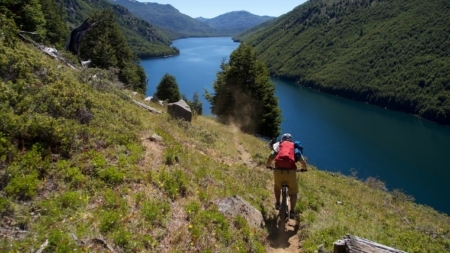On Trail and Off the Map
In Coyhaique, Chile, the ghosts of resource extraction may offer a path toward a new recreation-based future.
I zoom in on the satellite image on my phone, trying to see some vestige of a trail. The old road we’ve been riding has disappeared, leaving no signs of the next section of singletrack that will bring us to civilization. Behind me, I hear Gabo Benoit say in a somber tone, “We will let the animals guide us.”
We are deep in an unnamed mountain range outside of Coyhaique, Chile, on a faint path that (we hope) connects the small communities of Villa Ortega and Villa Mañihuales. Gabo, a local familiar with this terrain, points out a game trail freshly trampled by wild boars. This, he assures us, will lead to our destination. We continue forward cautiously, but forward nonetheless.
It’s February, and photographer Sam Appelbaum and I have been in the mountains around Coyhaique for just over a week, with another week to go. We’d been drawn south by the stories Gabo had told us about the trails we’d likely find in this remote stretch of the Patagonian Andes and had spent days riding, walking and pushing through narrow, near-invisible routes in thick forests, over high alpine ridges and along lakes that never seemed to end. Besides one remote farm, we’ve seen no signs of other people.
Which is exactly why we’re here: to help chart an abandoned network of old logging and mining roads and agricultural paths, connecting these small communities by reviving routes left from the area’s history of resource extraction. Once on the map, Gabo hopes the extensive trail system will attract hikers, mountain bikers and equestrians—and bring a recreation and conservation economy with them.
That’s the plan, at least.
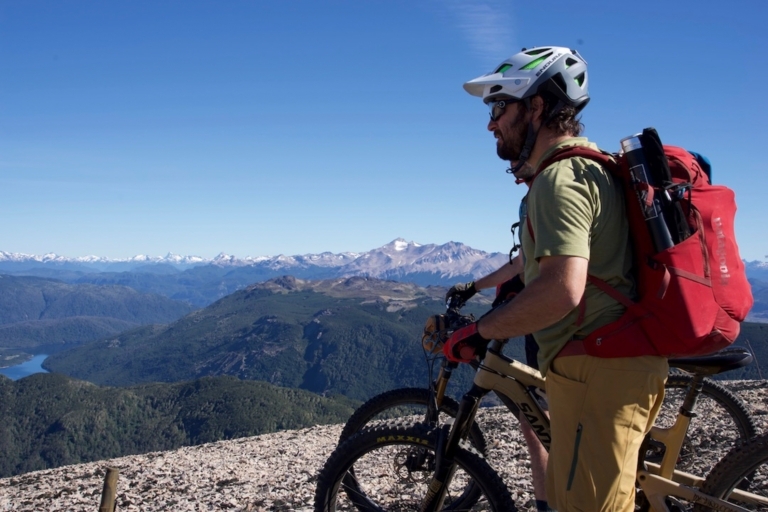
When mapping new trail networks, it always helps to have a view. Gabo Benoit and Sam Appelbaum survey some possible routes before starting another long descent. Photo: Max Wittenberg
Our journey to a wild-boar path in the Chilean mountains began six months ago, when I met Gabo in Downieville, California. He’d journeyed north to ride the area’s legendary trails, but he was also looking for ideas regarding his own hometown; specifically, how he could turn Coyhaique into an international mountain biking destination.
When it comes to using trails to reinvent a town, there are few examples better than Downieville. Once one of the centers of California’s Gold Rush and numerous logging booms, it was nearly abandoned by the 1990s—until a small crew of mountain bikers started a race based out of the town. That race, the Downieville Classic, is now one of the sport’s most legendary events, and its founders run the Sierra Buttes Trail Stewardship, a nonprofit advocacy organization looking to revitalize the area through recreation.
Gabo sees reflections of Downieville in Coyhaique. The 37-year-old Chilean grew up here and now lives just outside the 50,000-person city with his wife and three kids. He’s spent most of his adult life as a local fly fishing and mountain bike guide, building trails and charting routes in the area and, more recently, advocating for conservation and recreation-based tourism around his hometown. Historically, locals have relied on the logging, agriculture and cattle-grazing industries as their main sources of income, but those jobs have been dwindling as younger generations seek other avenues of work and leave their native lands for cities.
But while Coyhaique has lost some inhabitants, there are fresh faces as well—particularly those involved in tourism-related industries such as fly fishing, water sports and hiking, all of which are becoming increasingly popular in the area. Mountain biking is one of those, and Gabo says a mountain biking culture is slowly emerging in the town. The terrain is a unique mix of landscapes: vast expanses of tall craggy peaks reach high above the tree line and tower above picturesque glacial valleys containing jungle-like forests of dense, mossy vegetation. Southerly winds hammer the high-alpine zones, and consistent precipitation produces dreamy dirt—and perfect trail-building conditions.
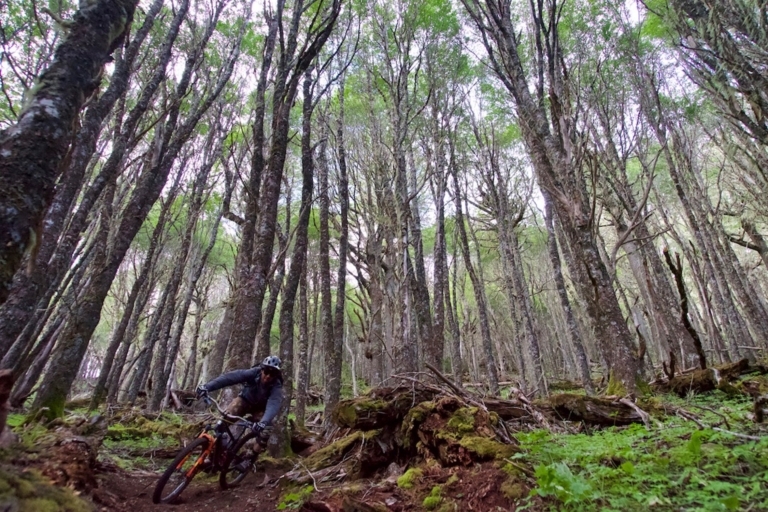
The riding around Coyhaique is a lesson in abrupt variety, where a few minutes can take riders like Max Wittenberg from above the tree line deep into thick, loamy forests. Photo: Sam Appelbaum
This soil-based bounty is not lost on Gabo. The former UCI World Cup downhill and Enduro World Series racer has spent years building trails around town, and we spent the first part of our trip sampling some of his signature creations. With names like Chicken Line and Don Choco, they have a raw and natural feel, usually falling from above treeline before turning into hand-carved masterpieces of steep, fast-yet-controllable flow.
Other locals have been working to grow the riding scene as well, and their efforts are apparent in the two public bike parks, El Fraile and La Gloria, we visited before heading into the mountains. Ironically, however, it is the area’s history of resource extraction that makes it so promising for outdoor recreation, mountain biking included. Decades of logging, mining, agriculture and ranching have left countless miles of abandoned dirt roads and singletrack, a network that once traversed the rugged mountains and connected scattered towns.
But that was years ago. Despite their abundance, few of the trails have been mapped, and most of them have been neglected due to their remoteness. Those wanting to navigate the wild terrain must rely on locals’ word of mouth and satellite imagery, both of which are becoming increasingly scarce: The older generation who once used the paths are passing away, and former thoroughfares are disappearing as they’re overgrown or washed away.
Gabo doesn’t want to see that happen. He’s been working to resurrect these trails before they completely fade away, organizing crews of local riders to brush and clear the routes and securing government funding to aid in new trail development.
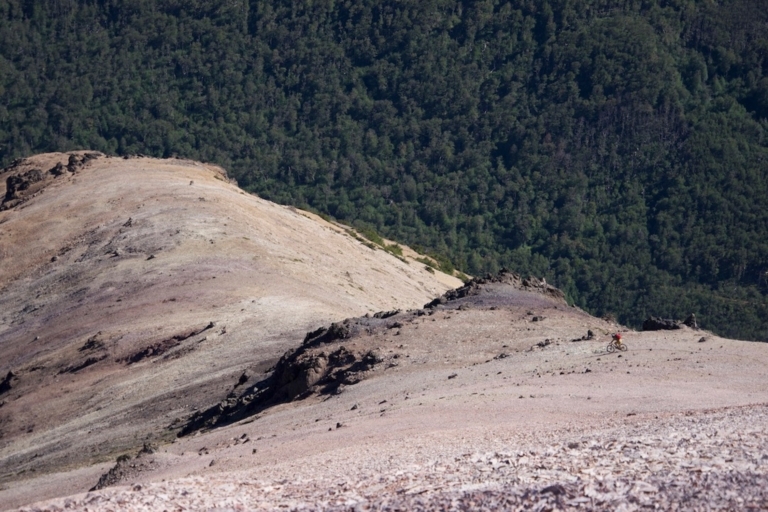
The terrain around Coyhaique is vast. Route-finding can be extremely difficult and usually involves climbing over and descending through multiple peaks and valleys in a single day’s ride. Photo: Max Wittenberg
Which brings us back to our current location, following wild boars in hopes of reaching the town of Villa Mañihuales, where a friend of Gabo’s is scheduled to pick us up and drive us back to Coyhaique. But after a half-hour of scouring over screenshots on our phone, we still can’t find a clear path forward. The eroded “roads” we’ve been following look more like riverbeds than anything you would drive a vehicle on, and we decide we have two options: continue forward or follow our GPS back to Fundo Lago Largo, the farm we’d stumbled upon the night before.
The owners, a retired family who spends their summers on the farm, had graciously provided us with food and a roof for the evening. One of the residents, a man named Victor, had been plying the trails in the area for 40 years and told us about some backcountry horse routes he’d ridden as a boy. We’d spent the morning trying to find those trails using Victor’s directions, but following a list of landmarks and old tree blazes in a remote Chilean mountain range is not as easy as he made it sound.
Directions or not, we are well-versed in our current situation: standing in confusion, trying to use our GPS to determine whether we are, in fact, riding a trail. Seeing the speed at which these heritage trails are disappearing, firsthand and on the ground, it’s hard not to feel beat down and discouraged—which is exactly why Gabo is making such an effort to reopen them.
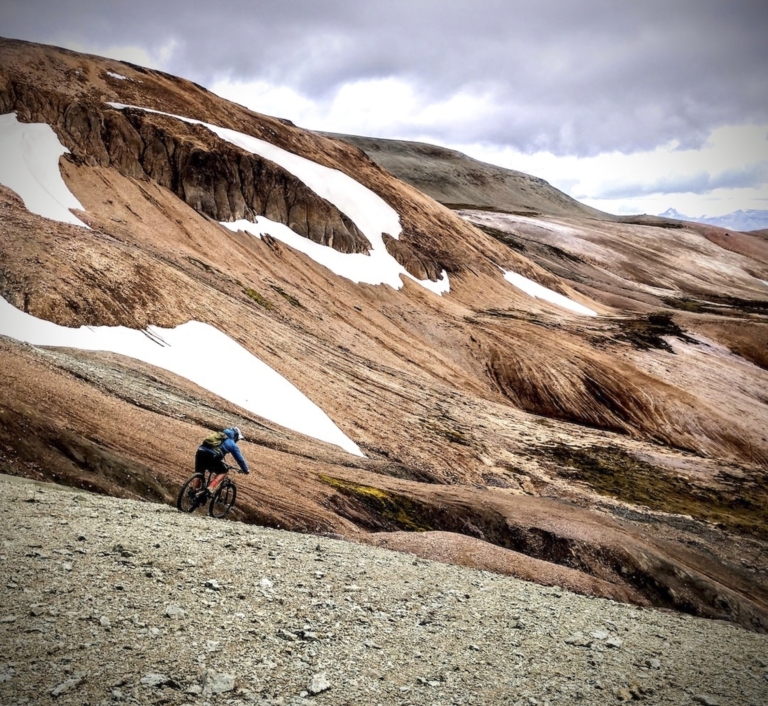
Gabo Benoit is well-versed in the Coyhaique, Chile, region’s unique landscape; not only is he a life-long local, he’s built many of the area’s most popular trails—like Chicken Line, an alpine classic. Photo: Max Wittenberg
Splitting from the boar trail, we push up and over what feels to be an endless hill to our next vantage point, where we spot a well-maintained dirt road winding down toward Villa Mañihuales. The country is in the midst of a heat wave; temperatures are already soaring towards triple digits, and we’re low on water. Climbing another peak, we decide, might not be in our best interest. Instead, we descend to the road, hop on our bikes and cruise into town to meet our driver.
Even as we struggle through the heat, quietly accepting that we won’t make it to Villa Mañihuales via singletrack, I can’t stop thinking of the area’s potential. It sits balanced between the healing scars of past industries and the budding future those scars can yet provide—multiple lifetimes worth of trail to explore, unforgotten but still not on the map.
